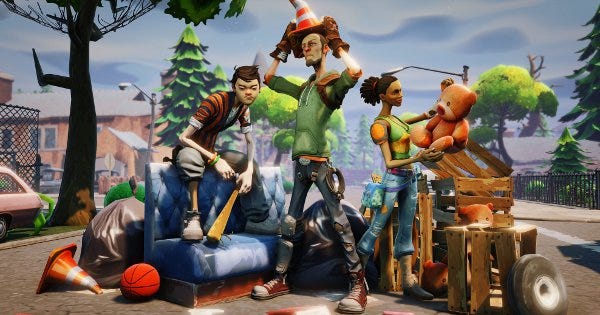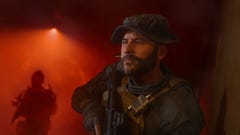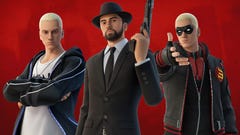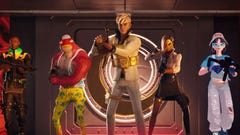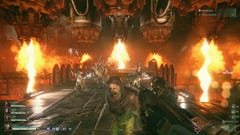Fortnite's Jessen Talks Minecraft, PC Gaming, UE4
The Not-So-Dark Night
It's been ages since Epic last took up PC gaming's banner and affixed some sort of completely bonkers weapon to it. Instead, the Unreal creator has been off duct-taping chainsaws to other platforms while we spill warm tears onto screenshots of Jazz The Jackrabbit. But no more. Epic recently announced that Fortnite - at least, for the time being - will be leading on PC and debuting Unreal Engine 4 to boot. So I had a massive chat with producer Tanya Jessen about that, during which we discussed Minecraft comparisons, the not-so-obvious benefits of Unreal Engine 4, Fortnite's cartoony art style, online aspects, and why Epic never really left the PC behind. It's all after the break.
RPS: When was Fortnite first conceived? Because I'm just going to put it out there: on paper it sounds a lot like Minecraft, but it seems like you're taking the sandbox-y elements and shaping them into more of an actual game. So how much of it was inspired by Notch's world-dominating world-building opus?
Jessen: Fortnite was a game that's existed in many forms and many ideas around the studio for a little while now - kind of as a result of people thinking about where the future of game development was heading. How are things changing?
I know at the time, one of the things I was thinking a lot about was, how do we get people with different personality types all playing together? Somebody, for example, who loves role-playing games being able to play with somebody who loves shooters. And there's been lots of games that have tried this in the past and haven't really succeeded, and so I was spending a lot of time thinking about that. I know Cliff [Bleszinski] was thinking a lot about more dynamic worlds, how to employ crafting and building within this dynamic gameplay, but yet have the action more integrated with it.
And that all started to culminate at a time when we were doing our game jam here at Epic. I don't know if you heard about it, we talked about that a little bit with Infinity Blade Dungeons. Our game jam was the place where Infinity Blade Dungeons was born. And when we pitched this idea of Fortnite, the company said, "Hey, why don't you come up with a pitch and work on some prototypes?" That was shortly after the game jam.
That was about nine months ago or so. But the ideas themselves have been around in lots of different forms for a pretty long time. It was just good timing, because we were sitting down as a company and prototyping out what some of those ideas could be. That, combined with the idea of what it was like when you were a kid - building a fort out in the middle of the woods or in your living room, all the things you had to do to scavenge for items around or protect your fort, or have fort battles with your friends - that's really what became the core of the idea for Fortnite.
RPS: But ideas don't form in a vacuum. So is there a direct influence from Minecraft? I'm just wondering, more so than "Oh my god, it's clearly a clone of Minecraft." Because obviously, it's not.
Jessen: I mean, to be quite frank, there's a lot of influences from a lot of different games in Fortnite. Like I was saying a little bit earlier, a number of the people on the team have a solid MMO and RPG type of background. There's definitely some element of that in there, as well as our pedigree from making Horde and more scripted and raid-based enemy gameplay and cooperative gameplay. So there's elements from all over the place. We're combining them and refocusing them in a way that's never really been seen before.
RPS: That's just sort of a thing, too, that I've noticed is kind of an Epic hallmark: you're really good at taking a mechanic that may have already existed, for instance something like the cover mechanic employed in Gears of War, and polishing it into something that really shines. I mean, Gears' active reload system is so simple, yet utterly brilliant. Is that also what's happening here? You're taking these elements and saying, "How can we wring the most fun possible out of them?"
Jessen: It's kind of more like... We're a studio full of people that love to play the games we make. And it sounds kind of selfish, but we're all gamers, and we all want to make the games that we want to play. So the result of what you see us putting out is often times exactly that.
In terms of our focus for the game - with the moment-to-moment in regards to combat, scavenging, and building - we want to be just ridiculously fun, no matter how much time you're spending in the game. So everything we're doing gameplay-wise is to support that. That's why with building, it's really easy and really fast so long as you have the skills and the resources to frame out what kind of structure that you want to build. But the deeper element of it is determining what kind of strategy you want to employ against the enemies when you're defending your base, or even just to make your fort look cool.
So making that fun at a basic level is what we're focusing on. With scavenging, it's the same thing, where moment-to-moment it's going to be fun, just that constant feeling of loot. What are you going to do with the items you got? What are the trade-offs you're making as a player? But deep in the sense that it's all based on how much you're willing to explore the world and discover the environment around you, because our worlds are totally dynamic. Or all of your friends' worlds that you would want to visit and find stuff in.
RPS: How open is the building system? I've noticed in screenshots, there are blueprints. Are you building off those? Can I also go totally freeform and mash parts together to see what works?
Jessen: It's based on discoveries. You unlock the ability to build lots of different building types. We don't even know the total number that we'll be shipping with day one, because we just continue to add to it. But for example, you've got a few basic items, structural items, floors, walls, stairs, roofs, ceilings. And all of those have a different type of blueprint, so you can decide if you want to place walls with doors, walls with windows only, window and a door, half-length floors, floors with railings, etc depending on your strategy and what you're trying to accomplish. The curve of the stairs, how you want to structure that. It goes pretty deep. [chuckles] And that all gets multiplied by the resource types that you can use to build those objects or upgrade those objects.
RPS: How does the structure of the game work? You were saying that I can be in my world or I can visit a friend's world. Is it one persistent world that I'm in, or are there sets of levels? How does Fortnite form a game around all of this?
Jessen: That's something we're still really iterating on and we're really deep in design, because we have a whole bunch of different options. The idea is that you can have multiple worlds that are public or private, they can be single-player or cooperative, and you can leave those open. In other words, you can be away from your PC, and they can be running. Or you can turn them off. It's up to you. But each of those environments will be dynamic and totally unique worlds. But in terms of the progression itself... Not ready to talk too much about that stuff. We have so many different things we're doing where we're iterating to find the most fun right now.
RPS: This is Epic's first Unreal 4 game, and that caused a big stir during Comic-Con weekend. It looks really nice, and the art style is very vibrant, but it's not like some of those trailers you've released where it's something people can look at and say, "Oh my god, this is the most gorgeous thing I've ever seen." So why did you decide to debut Unreal 4 with this, especially because, well, wouldn't it be possible to create a game like this - maybe not quite as graphically intensive - and have it on current-generation consoles as well?
Jessen: There's three or four major reasons. We had actually started prototyping the game on UE3, and the reason we decided to move to UE4 is because of the dynamic nature of the game. The tools in UE4 are completely changing, to the point where it gives a lot more control to designers and artists, to just create interactive objects in the world. That, for us, for Fortnite, that was a really great move, to be able to use the next version of Kismet. It's called Blueprint.
For example, our skybox is built entirely in a Blueprint, and that's the day-night cycle. All the programmers had to do was expose, you know, what time was it relevant to gameplay, and now the artists can go make all of these objects that are relevant to the time of day. So after a certain time, all the streetlights will turn on wherever you're at. The clocks in the world tell the actual in-game time. Things like that, in the past, would have to be programmed by a coder. Now they're all set up by our artists. Everything from how many different shaders in the colors of the sky that change depending on the night, that all now can be iterated and made awesome by the artists.
It puts so much power into our content game, wihch was huge for us. And the same with all of our enemy variants. We can set those up in Blueprint and then be able to give the power to the designers to create as many different types of enemies as they would want, based on an initial Blueprint. That's been really good for the project as a whole. And then on top of that, because Fortnite has so many different systems and it's really focused on fun gameplay, it allows the engine team to iterate much faster on all of the systems that are changing for Unreal Engine 4. We can get them in and try them out and that means it's going to be a better product for licensees and everyone else who uses the engine in the future.
We know what UE4 can do [graphically]. We've obviously shown you what UE4 can do, and so the benefit of being able to iterate quickly and take advantage of that workflow stuff for Fortnite on UE4 was, by far, for us, such a good decision. It's pretty much why we moved forward on that.
And also just from an accessibility standpoint, we wanted to make sure that UE4 was really accessible to people who own PCs today, that they'll be able to run a UE4 game. So Fortnite was a great opportunity for us to push for that as well.
RPS: I think the official line after all the smoke cleared at Comic-Con was that you're PC-only for now, with the possibility of it coming out on other platforms later on down the line. Even so, a lot of major triple-A developers would still be hesitant about launching PC-exclusive in this day and age. Do you feel like it's back as a viable triple-A platform?
Jessen: Well, I don't think that ever went away for us. We made games as the opportunity arose. But in particular, with Fortnite, because of its super-dynamic nature and the fact that we see this as a living project, the only platform for us that made sense was PC, and especially with turning around that quick iteration time with UE4 and all of that. It was absolutely the way to go. It's offering us the flexibility to add things on the fly. As people are having fun with certain weapons or enemies, being able to add more of that and keep the experience really fun and fresh for people is awesome. And right now you can't really do that so easily on consoles.
But like I said, [PC] never went away. Innovation has always been happening in the PC space. I've been a PC gamer my whole life, since I was like 12. That's what got me into the games industry: my love for Unreal and Duke Nukem 3D and all of that. I don't know if it's really a shift so much as that the flexibility of platform is something that's been absolutely awesome, that people are now starting to take more advantage of. Maybe it's just the fact that with the tools now, it's getting easier to put out games on the PC.
There's always been millions upon millions of people playing games on the PC. Maybe it's the fact that things are moving more towards digital distribution, and that's helped a lot. Because that was never an option, with bandwidth constraints and all that in the past. That certainly does allow you to be able to make updates more frequently and not have to worry about it being a pain in the butt to download all the time [chuckles].
RPS: That sounds a lot like, at least in theory, a free-to-play game, where it's continuously updating and people can pick and choose the way that they have their experience. Is that what you're aiming for?
Jessen: Haven't really discussed it yet. We're doing a lot of research to figure outhow we want to release it, but we want a lot of people playing this game, and we think it's the perfect kind of game that you're going to want to play with all your friends. So we'll just have to wait and see. That's for the business guys. [laughter]
RPS: Because you're on the PC - exclusively, for now - that obviously raises the question of piracy. That's a big thing that's kept developers and publishers off it in recent years. Do you have any sort of concrete plans to combat that?
Jessen: That's not really a place, I guess, that I should talk, because once again, that's more of a business question. Something for Mark, Mark can talk about piracy. [laughs] We're not concerned about that right now with what we're doing on Fortnite.
RPS: Given the opportunity, though, would you consider using a constant connection requirement, like what Diablo, SimCity, or some of Ubisoft's games have done? I mean, obviously, minimizing piracy's only one potential reason for that - with the others, at least, on paper, pertaining more to convenience.
Jessen: It's dependent more on gameplay for us, because Fortnite is a game that's being developed as a co-op experience primarily. That's our number one focus. This is the game that you're going to want to play with your friends and it's most fun with your friends. So whatever we decide to do there is going to be more relevant to what's the most fun experience you can have with your friends [than piracy]. But I can't really nail that down today.
RPS: It's certainly gotten a lot of discussion lately, though - with some developers even going so far as to call it the future. Meanwhile, the downside for players is that there's no true single-player at that point. You're always connected to servers. Are you still hoping to have a truly single-player experience in Fortnite as well?
Jessen: Yeah, absolutely. Single-player is going to be super fun. Like I said, we're building it to be a co-op experience, but [co-op] won't be required in any shape or form. In particular, we've got this personality we call the 'lone wolf' - the type of person who likes to jump in and play with their friends, but not necessarily all the time. Or they like to play primarily by themselves. We are definitely making sure that Fortnite will be fun for that type of person too.
One thing we've learned from our experiences is that if you don't design for co-op from the very beginning and make it a pillar of your project, then the game systems themselves don't tend to feel solid in the co-op experience. So that's how we're developing the game from the outset.
RPS: So whenever that Lone Wolf type of player plays the game, will they be required to be connected to the Internet, or will they be able to just boot up wherever and play?
Jessen: That's something that we don't know yet. It's going to be dependent on the gameplay. And it's also dependent on the platform and the method of getting updates and stuff like that. Can't necessarily say that today for sure, one way or the other.
RPS: Is out-of-the-box - or whatever the digital equivalent of a box is - mod support in the cards?
Jessen: As a studio, especially with UDK, with PC games we've always tended to support the mod community. I just can't necessarily announce anything like exactly what that is today. But I can assure you that we're thinking a lot about it and the best way that we can implement that with Fortnite - so that it's not just players putting stuff out there. It's more incorporated into the game itself.
RPS: Initially, Fortnite wasn't quite as cartoony, right? I think Cliff said during Comic-Con that early versions drew on stuff like The Walking Dead. Why'd you decide to move away from Epic's now-signature grimdarkness?
Jessen: Well, for us, there were two big reasons. One, because we consider this a living project, we want this to be a game that people are constantly coming back to and playing with their friends. We wanted the world to be just beautiful and awesome to be in at all times, and be able to give the world a lot more personality and flexibility in terms of doing lots of fun and crazy things in the space. One of the videos I showed was of some of our enemies and our weapons. We didn't necessarily want to be held back by any super-serious horror fiction, things like that. We really wanted to make a more lighthearted game.
And second, that offered a great opportunity for our artists to stretch their fingers out. I'd say stretch their legs, but it's more their fingers... [laughter] Playing around with a completely different look, totally stylized - this was very much a product that people wanted to make. It was pitched from the team. We said, "Hey, let's do something a little bit different and totally fresh for us." That's been a really nice departure for those guys, to riff on a completely different look and art style. They've been getting a kick out of it.
Even our containers [really mattered] - because everything in the game is like a treasure chest. Everything you see can be scavenged or searched through, and you have to make decisions like are you going to take everything? Are you going to leave some things? Do these things respawn? Are you going to destroy the item itself? It's pretty deep, but we wanted all of those objects to look really cool and fit within the Fortnite world, so that even just like... You could be in a building with nothing in it except for stuff, and you get a story of the fact that it was lived in - the people that were there. And that it fits perfectly within the world. That kind of narrative development, even just from the props and stuff, has been really fun for the team.
RPS: Ooooo, that sounds kind of like Bethesda-era Fallout. Is that what you're shooting for - that sort of subtle environmental storytelling?
Jessen: Because the worlds are dynamic, this has been the fun challenge for us - to be able to have that narrative, but also have dynamically created spaces. You can't necessarily make that one-to-one, because we're not scripting it. We're not creating that experience for you. You're creating that for yourself, which is what makes it that sandbox experience, you know? But it is definitely a focus in terms of the look and feel, and as a whole, on a big-picture level. Room to room, because it's dynamically created, it's not quite the same as, I'd say, a Fallout necessarily. But it is a big focus, to make it feel really unique and setting the tone of the world.
RPS: I read that I can upgrade my main weapon throughout the course of the game. But... can I put a chainsaw on it?
Jessen: [chuckles] So basically, the way that our weapons work is that they have gameplay modifiers, and that's what they were talking about. We're not going to go into any more detail there, but I'm certain that you'll see some very interesting things [knowing laughter] once we do announce more of that stuff.
RPS: Thank you for your time.
